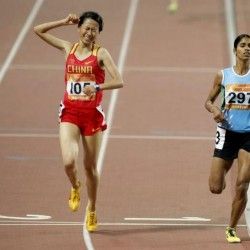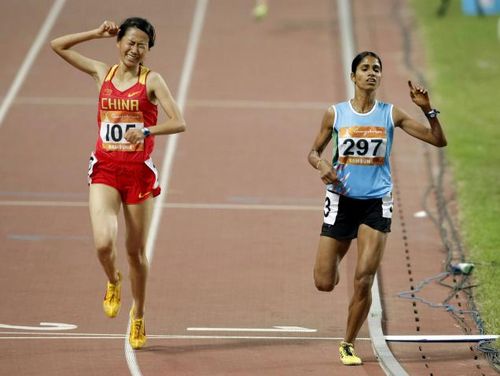
Why does a country as big and able as India fail to produce top class athletes?

Sudha Singh (right) wins gold in 3000m steeplechase at 2010 Asian Games in China
India is a sports crazy nation. It has the world’s second-largest population and is the 10th largest economy; it’s the biggest democracy in existence and one of the oldest nations in history. But why is India unable to win medals at the Olympics? The answer to this lies so deep that a gold miner will reach the earth’s crust when he starts digging for gold, and even then he might not find it. Though this analogy is a hyperbole, it pretty much sums up the state of athletes in India.
Though the population of India and China differs by a few tens of millions, India’s contribution to the Olympics is negligible. Much to it’s shame, even the United States with almost a fourth of India’s population has always held it’s flags high at the Games. This problem makes one wonder what exactly is wrong with the current state of affairs in India, and it is one that needs to be addressed soon.
In terms of the disparity between population size and medals won, there is no worse Olympic performer than India. It seems bizarre that a country of more than 1.2 billion people can only collect an average of less than one medal per Games.
Albeit without a gold medal, London 2012 was India’s most successful Olympics to date, where it finished with two silver and four bronze medals. That is over 200 million people per medal, the highest ratio of all competing nations at London. Compare that to China, with one medal for every 15.5 million people (for a total of 87 medals) or the U.S. with one medal for every three million Americans.
With an annual GDP of $1.842 trillion, India is the world’s tenth largest economy, according to 2012 World Bank data. Yet, it’s number of medals is far lower than that of countries with economies of comparable size. Take Russia; although its GDP is marginally larger than India’s, it won 82 medals at the London Games.
One had to scroll way down before getting to India in the Olympic rankings. It was 55th out of 79, below the likes of North Korea (20), the tiny Caribbean archipelago of Trinidad and Tobago (47) and nowhere near fellow BRIC economies. If the medal tally is adjusted to its population and the size of its economy, the result is even less remarkable; India comes last in both tables.
It would be false to say that India does not produce good sportsmen and women. In cricket, the country’s ardent obsession, it had in Sachin Tendulkar, one of the sport’s greatest ever players, until he retired from all formats at the end of last year. The Indian cricket team under it’s captain Mahendra Singh Dhoni has reached new heights winning the ICC World Cup and the Champions Trophy ever since it first won the inaugural T20 World Cup in South Africa in 2007. Saina Nehwal’s successes worldwide has made her India’s ambassador in badminton of late. The Indian men’s field hockey team won six consecutive Olympic Golds from 1928 to 1956 (field hockey accounts for more than half of India’s historical total of 26 Olympic medals).
There is no doubt that India has abundant talent in it’s repository; but why does it underperform at the Olympic Games?
The biggest problem is that Indian athletes don’t enjoy much financial or institutional support. Although this is improving, thanks to growing public investment and non-profit initiatives like the Olympic Gold Quest and the Mittal Champions Trust, this is in no way comparable to the kind of backing athletes enjoy in top-ranked Olympic countries.
“The correlation between the amount of money invested in athletes and the number of medals is very strong,” argues Geet Sethi, a nine-time world billiards champion as well as head and founder of the Olympic Gold Quest, an organization that scouts and trains athletes for the Games.
“For instance, in 1998 our sports budget was 1.5 billion rupees ($27 million) while China’s was 15 billion rupees. China won 10 times the number of medals India won at the 1998 Asian Games,” he said.
Olympic shooter Abhinav Bindra, who won gold in Beijing, agrees the room for improvement is plenty: “I think in sport in India a lot needs to still be done. I do believe that we have an abundance of talent but that talent needs to be nurtured right from a young age and we need to have world-class infrastructure, world-class coaching and training right from a young age.”
In an interview with India Real Time, he described China as a good example of how investing in sports translates into Olympic victories. “Their rise has been phenomenal,” he says.
Besides, India does not have the Communist history that Russia and China shared. Some argue that, over the years, this has translated into a sporting culture that is conducive to Olympic victory by making it easier to channel resources to athletes.
One of the other big problems of India paying less attention to the Olympic sports is its over-obsession with cricket. No doubt India has made itself prominent in the world with continual successes in cricket, it has kind of acted as a hindrance to the progress of other sports. More and more money is flowing into cricket with a number of sponsors lined up to provide support while other sports don’t get the financial injection they so badly require.
Most parents, if their children do take up sport as a profession, want them to become cricketers for obvious reason that there’s money and fame involved. Also, after the advent of the lucrative Indian Premier League around seven years ago, this mentality has become ever more deep-rooted in the psyche of the Indian public.
The thought of the inability of Indian athletes to gather medals at the Olympics occurs only once in four years, that too for a month or so when the media are covering it. The rest of the time, people are busy worshipping and enjoying the entertainment that cricket provides.